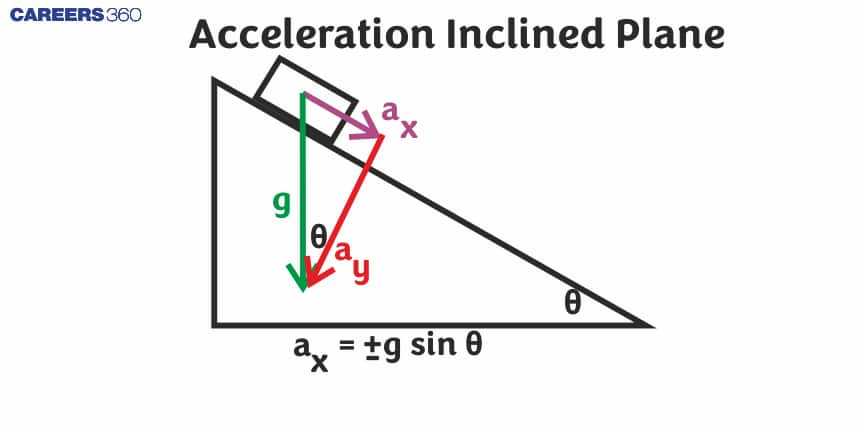Acceleration Inclined Plane -Explanation and FAQs
We use a lot of simple machines to move heavy loads from one point to another. One of them is an inclined plane. It is a plane surface which is set at an angle, other than a right angle, against a horizontal surface. An inclined plane is used to lift heavy loads with less force. The length of the inclined plane is always greater than the height of the inclined plane. So, the weight of the object can be moved along the inclined plane with less force. A playing slide in a park, flyovers, roads on hills and sloping ramps are inclined plane examples.
This Story also Contains
- Importance Of Inclined Plane
- Effect Of Incline On Forces And Acceleration
- Forces Required To Calculate The Acceleration Of An Object On An Inclined Plane

Importance Of Inclined Plane
An inclined plane is a term which is used in Physics to describe a tilted surface. When we place an object on a tilted surface, it will slide down the surface. Objects placed on an inclined plane accelerate because of unbalanced forces. Whenever we place an object on the inclined plane, there are always two forces acting on it.
The normal force acts in a direction perpendicular to the surface it is acting on and the force of gravity acts in a downward direction.
Effect Of Incline On Forces And Acceleration
Acceleration plays an important role in the field of science. The rate of change of the velocity of an object with time is called acceleration and it is a vector quantity. So, it has magnitude and direction.
The force of gravity is not perpendicular to the surface in the case of an incline. As an incline angle increases, the normal force and the force of friction decrease while the force of gravity remains the same.
So, net force and acceleration increase as the incline angle increases.
Forces Required To Calculate The Acceleration Of An Object On An Inclined Plane
The free-body diagram of an object on an inclined plane is shown in the figure given below:
First of all, we need to identify the mass of the object, the coefficient of friction and the angle of the inclined plane. Then we have to calculate the following forces which act on an object which is placed on an inclined plane.
The Force Of Gravity: This force is the mass times the acceleration of gravity. As we can see from the above diagram, this force is acting in a downward direction and its value is mg

As we can see from the above figure, there are two components of this force which are mgcos\theta ![]() and mgsin\theta
and mgsin\theta ![]()
Where g ![]() is the gravitational acceleration and m
is the gravitational acceleration and m ![]() is the mass of the object.
is the mass of the object.
Normal Force: As we can see from the above diagram, the normal force is acting perpendicular to the direction of the inclined plane. This normal force is denoted with the symbol F_{N} ![]()
Force Of Friction: The force of friction fs is acting opposite to the motion of the block which is shown with the symbol f_{s}

It is important to note from the above figure that the perpendicular component of the force of gravity mgcos\theta ![]() balances the normal force and the parallel component mgsin\theta
balances the normal force and the parallel component mgsin\theta ![]() and the friction force should be added together. Now, to find the net force, all the forces should be added. The net force can be defined as the vector sum of all the forces acting on the object which is placed on an inclined plane.
and the friction force should be added together. Now, to find the net force, all the forces should be added. The net force can be defined as the vector sum of all the forces acting on the object which is placed on an inclined plane.
After calculating the net force, apply Newton’s second law which states that the net force on the object is equal to its mass times its acceleration. F_{net}=ma ![]()
Where a ![]() is the acceleration of the object and m
is the acceleration of the object and m ![]() is the mass of the object.
is the mass of the object.
From this, we can calculate the value of the acceleration of an object on the inclined plane.
Frequently Asked Questions (FAQs)
There are two types of forces. Contact force and non-contact force. Forces which act on objects directly or through a medium are known as contact forces. Tension, normal, spring and frictional force are some examples of contact force.
Forces which act on an object without any contact are said to be non-contact forces. Non-contact forces act when there is no contact between two objects or the objects is very far away. Strong nuclear force, gravitational force and weak nuclear force are some examples of non-contact force.
If the velocity of an object is increasing with time, then we can say that the acceleration of that object is positive.
The uniform acceleration produced in a freely falling object due to the gravitational force of the earth is called acceleration due to gravity.
The SI unit of force is Newton.
No, force is not a scalar quantity. Force has both magnitude and direction and that is why we can say that force is a vector quantity.